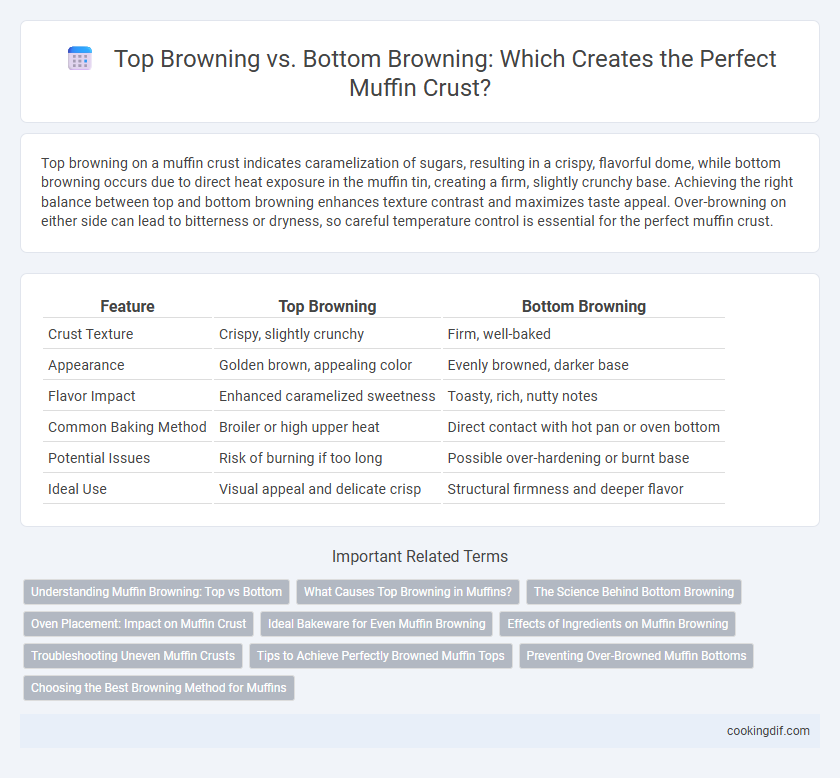Top browning on a muffin crust indicates caramelization of sugars, resulting in a crispy, flavorful dome, while bottom browning occurs due to direct heat exposure in the muffin tin, creating a firm, slightly crunchy base. Achieving the right balance between top and bottom browning enhances texture contrast and maximizes taste appeal. Over-browning on either side can lead to bitterness or dryness, so careful temperature control is essential for the perfect muffin crust.
Table of Comparison
| Feature | Top Browning | Bottom Browning |
|---|---|---|
| Crust Texture | Crispy, slightly crunchy | Firm, well-baked |
| Appearance | Golden brown, appealing color | Evenly browned, darker base |
| Flavor Impact | Enhanced caramelized sweetness | Toasty, rich, nutty notes |
| Common Baking Method | Broiler or high upper heat | Direct contact with hot pan or oven bottom |
| Potential Issues | Risk of burning if too long | Possible over-hardening or burnt base |
| Ideal Use | Visual appeal and delicate crisp | Structural firmness and deeper flavor |
Understanding Muffin Browning: Top vs Bottom
Muffin browning occurs due to the Maillard reaction and caramelization, which differ in intensity between the top and bottom crust. The top browning results from direct oven heat and air exposure, creating a golden, slightly crisp surface, while the bottom browning is influenced by the baking pan's conductivity, often producing a deeper, more uniform crust. Understanding these factors helps achieve the ideal muffin texture and appearance, balancing moist interiors with well-developed crusts.
What Causes Top Browning in Muffins?
Top browning in muffins is primarily caused by Maillard reactions and caramelization occurring on the surface due to high oven temperatures and sugar content in the batter. Exposure to direct heat from the oven's upper heating element accelerates browning on the muffin tops, especially when baked in convection ovens. Sugar concentration and moisture evaporation on the surface also contribute to the development of a golden-brown crust that enhances flavor and texture.
The Science Behind Bottom Browning
Bottom browning in muffins occurs due to direct contact with the hot baking pan, which transfers heat more efficiently to the lower surface, intensifying the Maillard reaction and caramelization processes. This results in a crispier, darker crust compared to the top, where heat exposure is more diffused and moisture often accumulates. Understanding pan material and oven temperature can help control bottom browning for optimal muffin texture and flavor.
Oven Placement: Impact on Muffin Crust
Oven placement significantly impacts muffin crust browning, with top racks promoting more intense top browning due to closer proximity to the heating element, resulting in a golden, crisp crust. Bottom racks encourage bottom browning, as the muffin tin absorbs direct heat, producing a firm, well-cooked base essential for structural integrity. Optimal muffin baking often involves middle rack use, balancing even heat distribution to achieve uniform crust browning on both top and bottom surfaces.
Ideal Bakeware for Even Muffin Browning
An ideal bakeware for even muffin browning is made of light-colored aluminum or non-stick metal, which ensures consistent heat distribution to prevent excessive top or bottom crust browning. Silicone muffin pans often result in uneven heat conduction, leading to bottom browning, while dark-colored pans absorb more heat, causing the bottoms to brown too quickly. Using standard aluminum bakeware provides balanced crust color by promoting gradual and uniform baking throughout the muffin.
Effects of Ingredients on Muffin Browning
Sugar content in muffin recipes significantly influences crust browning, as higher sugar levels promote Maillard reactions and caramelization, resulting in a darker top crust. Fat type and quantity affect heat distribution, with butter encouraging even top browning due to its water content, while oils may cause more bottom browning. Leavening agents also impact crust color; baking soda increases alkalinity, enhancing Maillard browning on the top, whereas baking powder produces a lighter crust overall.
Troubleshooting Uneven Muffin Crusts
Top browning on muffins typically indicates the oven temperature is too high or the baking time is too long, causing the surface to cook faster than the interior. Bottom browning often results from placing muffin pans too low in the oven or using dark-colored pans that absorb more heat, leading to uneven heat distribution. Adjusting oven rack position, using light-colored pans, and monitoring internal temperature with a baking thermometer can help troubleshoot and achieve evenly browned muffin crusts.
Tips to Achieve Perfectly Browned Muffin Tops
Achieving perfectly browned muffin tops requires controlling oven temperature and positioning; baking at 375degF encourages even top browning through Maillard reactions without overcooking the bottom crust. Using a light-colored, non-stick muffin pan helps prevent excessive bottom browning by reflecting heat and promoting airflow. Rotating the pan halfway through baking ensures uniform heat distribution, resulting in golden, crispy tops and tender, evenly baked muffin bottoms.
Preventing Over-Browned Muffin Bottoms
Preventing over-browned muffin bottoms involves controlling oven temperature and using proper baking equipment. Insulating the muffin pan with a silicone liner or placing a baking sheet underneath can reduce direct heat exposure to the bottom crust. Adjusting rack position in the oven also helps ensure even baking, avoiding excessive bottom browning while achieving a golden top crust.
Choosing the Best Browning Method for Muffins
Top browning of muffin crust creates a golden, slightly crisp surface that enhances texture and visual appeal, while bottom browning ensures a well-cooked base that prevents sogginess. Selecting the best browning method depends on desired texture: top browning suits muffins needing a crunchy, flavorful crust, whereas bottom browning is ideal for a firm foundation and even cooking. Oven temperature and placement on the rack significantly influence browning effectiveness, with higher heat promoting top crust color and direct contact with a heated pan encouraging bottom crust browning.
Top browning vs Bottom browning for muffin crust Infographic

 cookingdif.com
cookingdif.com